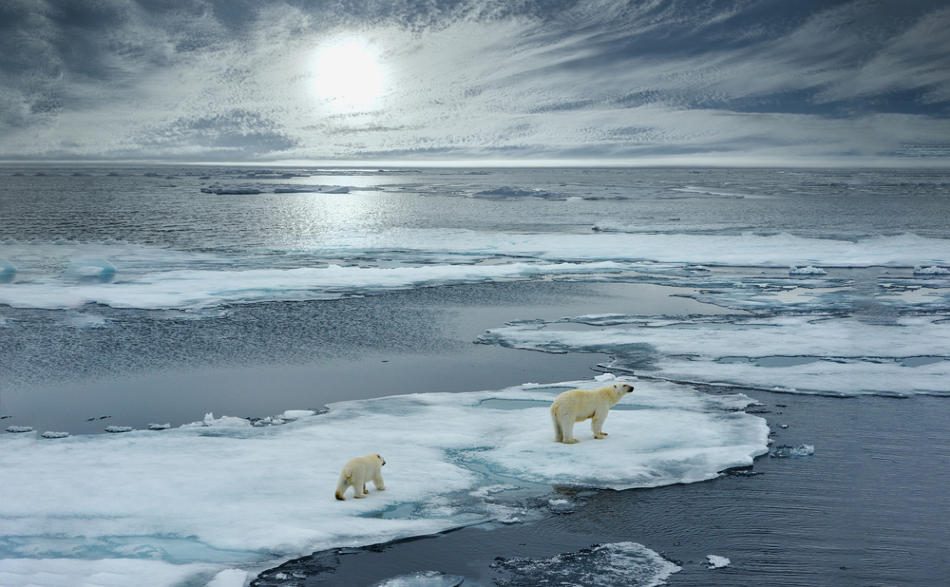The Ecological Impact of Climate Change on Polar Bears
By Megan Ray Nichols Mar 10 2020

Image Credit: FloridaStock/Shutterstock.com
The starving polar bear has become one of the most famous images of climate change and of the impact that rising temperatures have on life in the Arctic.
Polar bears, which are currently listed as vulnerable on the Red List of Threatened Species and considered at high risk of endangerment in the wild, have traditionally been considered an animal that is one of the most susceptible to environmental changes. However, in 2015, researchers found that the species population in the South Beaufort Sea had declined by 40% from 2001 to 2010.
New research has given us an even better picture of the impact climate change has on polar bears.
The Current Impact of Climate Change on Polar Bears
Experts have linked the decline in polar bear populations to receding sea ice. In January 2020, the Arctic ice sea extent was around 770,000 square kilometers below the 1981 to 2010 averages for the month. However, until recently, researchers did not fully grasp why the decline of ice had such an effect on the animals. New information has provided a clearer picture.
A 2018 study provided a metabolic analysis of the species by tracking nine free-range polar bears over two years. During this period, researchers found that the animals' caloric needs are more than 60% greater than previously believed and they burn through around 12,325 calories per day. Because of this need, their diet consists almost entirely of calorie-dense ringed and bearded seals, whose populations are also declining as the result of sea ice loss.
Related Stories
MIT Study Analyzes Outcomes of State-Level Renewable Energy and Carbon Pricing Policies
Full Plug In Hybrid Concept Car From BMW Demonstrates Efficient Dynamics
What is Circular Fashion and How Could it Benefit our Environment?
When land-fast sea ice melts, it forces polar bears back onto land, where they do not have access to seals. While these bears are known to hunt and scavenge on land when seals are scarce, the food they find such as goose eggs, caribou, and whale carcasses washed ashore, cannot support their calorific needs. As a result, polar bears effectively begin to fast, struggling to keep themselves at a healthy weight.
One bear tracked by the researchers lost more than 44 pounds during the study and jumped into the sea in a failed attempt to catch a passing seal. More than half of the bears tracked by researchers lost body weight over the study period.
Researchers currently expect polar bear populations to decrease by more than two-thirds by 2050, bringing the total polar population below 10,000. However, this new study suggests that because the animals need more food than previously thought, climate change may have an even more significant impact.
Other new research makes further predictions even lower. For example, a recent study found that malnourished polar bears tend to have fewer cubs and that those cubs tend to have lower survival rates.
Experts do not fully understand the effect that ice loss is having on polar bear behavior. As the ice melts, these bears become predictable and harder to track. Better technology that helps scientists track their movement may help improve our knowledge in the near future.
Melting Ice May Lead to Other Threats
Other newer threats that have arisen as the result of ice loss could have further implications on polar bear populations.
For the past few years, the Arctic sea ice extent has regularly tracked below average. As a result, the Northern Sea, which was previously inaccessible to ships not accompanied by icebreakers, has opened up. The result has been steadily increasing numbers of cargo ships passing through the Northern Sea route: a cause of serious concern for conservationists and ecologists.
For instance, a total of 94 boats sailed the waters in the last week of August 2019, a vast majority of which followed the western parts of the route, where ice vanished in July.
Organizations such as the European Federation for Trade and Environment have raised concerns about the potential environmental impacts that increased shipping could have on the Arctic, including oil pollution from the hulls of unreinforced ships damaged by sea ice, or the release of black carbon by cargo ships. This gas can have severe impacts on both animal and plant life. Plus, when it falls to the ground with precipitation, such as rain, it darkens the surface of snow and ice, reducing reflection, warming the snow, and quickening melting.
The Future for Polar Bears and the Arctic
As the acceleration of climate change, increased sea ice melt is not inevitable; while the current numbers look grim, researchers say we have not passed any kind of tipping point that guarantees sea ice loss.
Experts say atmospheric carbon dioxide is one of the primary drivers of increased temperatures and has led to the loss of sea ice that polar bears depend on. Regulations and initiatives that reduce emissions or sequester carbon dioxide currently in the atmosphere could help prevent further ice loss and save the habitats of both polar bears and the species they depend on.
References and Further Reading
USGS. (2014) New Scientific Study Supports that Capture-based Research is Safe for Polar Bears. [Online] Available at: https://www.usgs.gov/news/new-scientific-study-supports-capture-based-research-safe-polar-bears (Accessed on 6 March 2020).
A. M. Pagano, G. M. Durner,K. D. Rode, T. C. Atwood, S. N. Atkinson, E.Peacock, D. P. Costa, M. A. Owen, T. M. Williams. (2018) High-energy, high-fat lifestyle challenges an Arctic apex predator, the polar bear. Science, 359(6375), pp.568-572. https://science.sciencemag.org/content/359/6375/568
Thomas G. Smith & Christian Lydersen (1991) Availability of suitable land-fast ice and predation as factors limiting ringed seal populations, Phocahispida, in Svalbard, Polar Research, 10(2), pp.585-594. https://doi.org/10.3402/polar.v10i2.6769
Stokstad, E. (2010) How to Save Polar Bears. [Online] American Association for the Advancement of Science. Available at: https://www.sciencemag.org/news/2010/12/how-save-polar-bears (Accessed on 6 March 2020).
Laidre, K. L., Atkinson, S., Regehr, E. V., Stern, H. L., Born, E. W., Wiig, Ø., Lunn, N. J., and Dyck, M.. 2020. Interrelated ecological impacts of climate change on an apex predator. Ecological Applications 00( 00):e02071. https://doi.org/10.1002/eap.2071
Staalesen, A. (2019) There is no ice left on Northern Sea Route. [Online] The Barents Observer.Available at:https://thebarentsobserver.com/en/arctic/2019/08/there-no-ice-left-russias-northern-sea-route (Accessed on 6 March 2020).
Bannon, E. (2018) Fears for Arctic ecosystem as shipping milestone reached. [Online] Transport & Environment. Available at:https://www.transportenvironment.org/news/fears-arctic-ecosystem-shipping-milestone-reached (Accessed on 6 March 2020).
Cho, R. (2016) The Damaging Effects of Black Carbon. [Online] Columbia University. Available at: https://blogs.ei.columbia.edu/2016/03/22/the-damaging-effects-of-black-carbon/ (Accessed on 6 March 2020).
Leahy, S. (2018) Polar Bears Really Are Starving Because of Global Warming, Study Shows. [Online] National Geographic. Available at: https://www.nationalgeographic.com/news/2018/02/polar-bears-starve-melting-sea-ice-global-warming-study-beaufort-sea-environment/ (Accessed on 6 March 2020).
Williams, M. (2015) Polar bear population decline a wake up call for climate change action. [Online] World Wildlife Fund. Available at: https://www.worldwildlife.org/stories/polar-bear-population-decline-a-wake-up-call-for-climate-change-action (Accessed on 6 March 2020)
Disclaimer: The views expressed here are those of the author expressed in their private capacity and do not necessarily represent the views of AZoM.com Limited T/A AZoNetwork the owner and operator of this website. This disclaimer forms part of the Terms and conditions of use of this website.

Written by Megan Ray Nichols is a technical writer and blogger who covers industrial and scientific topics. She has three years experience covering these industries writing for sites like Thomas, IoT Times, IndustryWeek and Discover Magazine. Megan also writes easy to understand science articles on her blog, Schooled By Science , to encourage others to take an interest in these subjects. Outside of work, Megan enjoys exploring local nature trails, stargazing, and curling up with a good book.
No comments:
Post a Comment